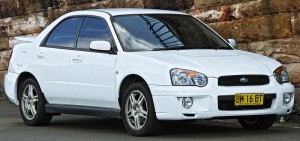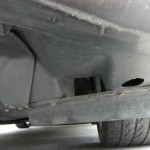Popular Posts
- Don't Block or Remove the EGR Valve, It's Saving You Money
- Keep Your Engine Alive: The Importance of Oil Temperature
- Low Temp Thermostats: What's the Advantage?
- Beating the Heat: Advantage of a High Pressure Radiator Cap
- Wheel Tech, Part III: Wheel Diameter's Effect on Performance
- How to Compare Weight Savings to Horsepower Gains
- Check Your Engine's Health: With a Vacuum Gauge
- Wheel Tech, Part II: Width Matters
- What's So Wrong With Nitrous?
- Stiff Stuff: Strut Bars and Braces
Resources & Classes
-
Category Archives: Braking & Handling
Modifications That Work Every Time: Suspension
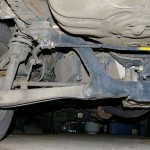 Continuing on with my series on modifications that work, this time we'll be tackling some of the modifications that will improve handling on any car, almost without question. Last time we finished up our list of modifications that work every time for engine performance (part ii)) and before that, part i.
Continuing on with my series on modifications that work, this time we'll be tackling some of the modifications that will improve handling on any car, almost without question. Last time we finished up our list of modifications that work every time for engine performance (part ii)) and before that, part i.
So let's dive in with the #1 modification you can do to really change the handling performance of your vehicle:
Fitting stickier tires will always improve grip and track times at the expense of fuel economy. The downside to these sticky tires is that they don't work well if they're not warm so all-season performance is out. You also have to balance the operating conditions with the size of the tire as if the tire is too wide, it may not get up to temperature quickly, too narrow and the tire may actually get too hot and get "greasy" or fail prematurely. Sticky tires also increase rolling resistance which affects fuel economy negatively (by up to 1-2%) and because they're soft they also wear out VERY fast. However, nothing will improve the overall performance of your car like a great set of performance tires so don't skimp on this if your goal is all-out performance. See related articles at bottom of this post for further reading. (more…)
Posted in Braking & Handling
Comments Off on Modifications That Work Every Time: Suspension
Impreza Not Too impressive: Handling Upgrades
Today I'm sharing a reader's question that I thought would resonate with a lot of you.
"Hello,
I have been reading some of these articles and I am very impressed by the information provided.This is my first all-wheel drive and I have to say, the handling is NOT as good as I thought it would be, especially on wet roads.
I have noticed that if I turn hard into a corner in the wet, the front seems to have a mind of its own and it looses grip. If I back off a bit, if feels like I'm not going to make the corner. I would like to achieve better handling, but I am unsure of the best way to go about this. Looking at the wheels, it seems obvious that there is plenty of room for wider wheels, but after reading your articles, I am reluctant to change the wheels. So, the next thing to consider is better rubber? Suspension improvements? Anything I do to this car, I need to consider that I can not make any changes that disrupt the warranty conditions and I certainly don't want to risk turning the car into a danger and/or a cop magnet. Any suggestions? -- Peter W.
Posted in Braking & Handling
1 Comment
Stiff Stuff: Strut Bars and Braces
No matter what car you drive, there are a number of suspension braces available 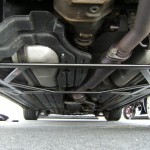 to supposedly improve handling. People shell out hundreds, even thousands of dollars on strut bars, under body braces, suspension member braces, fender braces, and frankly braces that attach to just about anything that has a bolt in it.
to supposedly improve handling. People shell out hundreds, even thousands of dollars on strut bars, under body braces, suspension member braces, fender braces, and frankly braces that attach to just about anything that has a bolt in it.
But what do these bars really do, if anything? Are all braces the same or are there important differences between them?
In today's article, I hope to begin to decode a little bit about each of these extremely important questions. While everyone just assumes they wouldn't be so popular if they didn't "work", I am here to tell you that there are far more bad products on the market than good ones - especially when it comes to chassis braces.
I am going to limit my discussion here to strut braces as they are generally the most effective and common. However, aside from placement, all other braces you can fit to your car are going to have a similar function. (more…)
Posted in Braking & Handling
4 Comments
Clever Tricks for Improving the Location and Height of The Center of Gravity
Most enthusiasts are aware that lowering a car's center of gravity is good for handling and indeed, grip.
It's easy to see the real world implications as well when we think about how a tall SUV handles versus a very low Ferrari or Corvette.
Where the Center of Gravity Is
The car's center of gravity has both a horizontal (x, y) and vertical (z) location and actually refers to a single point where if suspended, the car would balance perfectly (at least in theory).
So vertically, we already know that the lower the center of gravity - the better. What about horizontally? Well, again, take a look at super cars - the closer weight is to the center of the vehicle the better. This is why super cars are typically mid-engine, so the heaviest part of the car (the engine/transmission) is closer to the middle of the vehicle.
The center of gravity in most cars is roughly at the top of the front bumper in terms of height (just a very rough estimate). The (x,y) coordinate of the center of gravity is much more variable, the Y being affected by the car's front and rear weight distribution. So in most cases, the CoG is at bumper height, somewhere in front of the midline of the car as you look at it from the side of the car. As you look from the front of the car, it is going to be either in the driver or the passenger's lap as most cars are slightly heavier on one side or the other.
Improving Center of Gravity - Vertically
Lowering a car is one way to improve the vertical center of gravity. This will offer increased stability, lessen the risk of roll over in extreme situations, and in most cases increase lateral grip (or the "g" handling figures on the skid pad). There are practical limits on how low you can go due to road imperfections and so on. There are also limits on how low you can go on a factory suspension without actually hurting handling. Usually around an inch of lowering is the farthest you can go without serious changes to your suspension geometry... but more on that in another article.
Vertical CoG can be improved by removing weight or choosing not to locate weight high in the vehicle. You can also get a CoG advantage from choosing a vehicle without a sunroof. Sunroofs in modern cars are around 25-30lbs, but in older vehicles they were sometimes 40-60lbs. In any case, take note that BMW thought it worth the exceptional expense to use a carbon fiber roof on many of their M vehicles. A few pounds on the roof of a vehicle can make a significant difference on the track, and 10-15 lbs can make a noticeable difference even on mountain roads.Having removed the sunroof on a car before, I can say that removal is not ideal (reasonably expensive) and you'll be better off to start with a car without a sunroof if possible.
Posted in Braking & Handling
2 Comments
The 5 Best Bang for Your Buck Mods
If I could do only 5 performance modifications to a car, with cost being a consideration, and perhaps also wanting to strongly avoid "ruining" the car, what would I do?
Posted in Braking & Handling, Engine
4 Comments
Ingenious Designs: OEM Brake Ducts
A lot of car guys give the OEMs a pretty underwhelming amount of credit. However, I think what they fail to remember is that the original manufacturer, while concerned with many things we typically are not concerned too much with (noise/harshness/cost/etc), spends more money designing the heater knob in your car than most aftermarket part companies make in a decade. Seriously, they're that serious (especially the Japanese and Germans!)
In other words, despite there being some very clever tuners out there, the OEMs are usually FAR more clever (and better funded/resourced) than we give them credit for - and thus, in the right cars, they can be a great source of inspiration.
Older cars and slower cars can always look to newer and faster cars for great ideas. In this article, I'm going to show you how you can look to ingenious OEM designs to improve your own car.
Discovery
While working on Project Lexus, I was thinking about putting together an article on a cheap brake upgrade in the form of brake ducts. We'll probably do something on that in the future, but while doing a bit of research, I noticed that the IS300 actually already has brake ducts - and some rather clever ones at that!
They actually have implemented them in a way that many of you can replicate to reduce drag AND get some really effective brake cooling in the process. (more…)
Posted in Braking & Handling
Comments Off on Ingenious Designs: OEM Brake Ducts
Wheel Tech, Part III: Wheel Diameter’s Effect on Performance
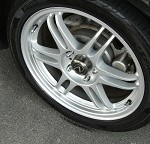 This is the third in a series on how wheel choice can affect your car's performance.
This is the third in a series on how wheel choice can affect your car's performance.
Should you fit 14s, 15s, 16s, 17s, 19s, 22s? This article will help you decide what size is right for you.
I've been working on debunking some long standing myths in this series and if you missed last week or the week before, I recommend that you check those out as well:
Last week I explained how changing wheel width too much on a street car can change your car's handling at the limit and how it can actually make for some dangerous situations in the more extreme cases. We discovered that wider wheels do not always (and in most cases never) increase the car's ability to grip the ground in the corners and how wider tires do not necessarily put more rubber on the ground.
Fortunately, while wheel width is limited by suspension geometry, wheel diameter can be whatever you like, as long as it fits and you're willing to accept certain trade offs. But before you go thinking it's a total free for all, let's talk about the ways wheel diameter affects your car's performance and the trade offs you make, especially when going larger.
Posted in Braking & Handling
14 Comments
Wheel Tech, Part II: Width Matters
Last time, we talked about the various ways that wheel weight affects vehicle handling, ride quality and both acceleration and deceleration.
While wheel weight might affect the performance of your car, wheel size can affect both the performance and the safety of your car. This article could frankly save your life or the life of someone near to you.
Unfortunately, there are a number of enthusiasts out there that by following typical forum/magazine myths about wheel sizing, have put us all in danger. Many of these myths have been around for literally decades.
You see, what I've found is that if enough people say something long enough and loud enough, everyone begins to accept it as fact even if it's not necessarily true.
This is certainly true of the general rules of wheel size selection that you get on forums and even in magazines.
Here are some of the myths you probably have been led to believe:
- Larger rims with lower profile tires handle better
- Wider tires give better grip and thus better handling
Both of these are (for almost all enthusiasts) entirely incorrect.
Posted in Braking & Handling
4 Comments

